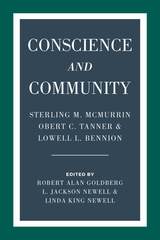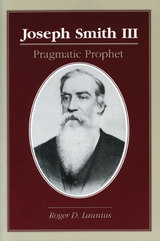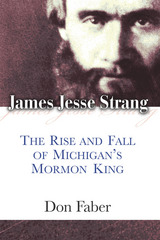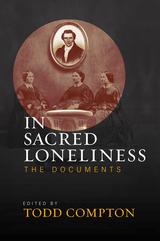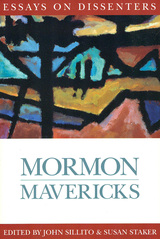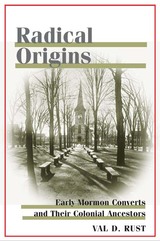Paper: 978-1-56085-284-1 | eISBN: 978-1-56085-383-1 | Cloth: 978-1-56085-192-9
Library of Congress Classification BX8680.S88S86 2006
Dewey Decimal Classification 289.3092
Strang was considered the prophetic successor to Joseph Smith for the Mormons of the Midwest who later formed the nucleus for the membership of what is now the Community of Christ. Today, 150 years after Strang’s death, about 100 faithful followers in the United States still await the emergence of another prophet to succeed Strang. In the prophetic tradition of Joseph Smith, Strang similarly excavated ancient metallic plates and translated them into the Book of the Law of the Lord and the Rajah Manchou of Vorito. Like Joseph Smith, Strang instigated polygamy, secret ceremonies, baptism for the dead, and communal living. He also introduced a bloomer-like fashion for women, as well as other innovations. Like Joseph Smith, he had himself crowned king of the world.
Where previous treatments of Strang have relied either on inside or outside sources to show either a prophet or charlatan, Speek utilizes all sources, updates the record, corrects previous errors, and shows diverse perspectives. She recounts the turbulent and dramatic events of the 1840s-50s, including the plot to murder Strang and the heartbreaking exile of the Saints from Beaver Island. She traces the dispersion of this once formidable colony of Mormons to the forests of northwest Wisconsin, the far-flung outposts of southwest New Mexico, the hills of Lamoni, Iowa, and to Salt Lake City, Utah.
- _Chapter 1.
THE PROPHET AND HIS WIFE
1813-1843
Thus we were left in destitution and ... [were] left on the dock at Chicago to go where we pleased and find a home ... where we could. Here we were left without shelter, the sun beaming down at fever heat. Here we were made a gazing stock for all kinds of people to stare at. One man began to swear at the [onlookers] ... and with some manly feelings he shoved the large warehouse doors apart and said, 'Here, ladies and gentlemen, come in here out of the sun and stay until you can find places.' This was the first kind word that we had heard from any one during the whole proceedings._--Wingfield W. Watson to Milo M. Quaife.1
It was indeed a hot day in early July 1856 when a large group of Mormons stood in the sweltering sun on a dock in Chicago, uncertain what to do. Only two days before, they had been forced from their homes on Big Beaver Island in the middle of Lake Michigan, herded onto departing ships like cattle, and stripped of their possessions. Their religious leader, James Jesse Strang, lay on his death bed in Wisconsin, dying of wounds administered by former friends and followers. Homeless and leaderless, the destitute Mormons prayed for divine guidance. ...
* * * * *
Jesse James Strang was born in the town of Scipio, Cayuga County, New York, on March 21, 1813, the son of Clement Strang and Abigail James. There was no indication the child would grow up to be a leader, let alone a prophet. Both of his parents were small in stature. Clement stood only about five foot three, while Abigail measured even less. However, James wrote that his were "comely in appearance, amiable, affectionate, charitable, remarkably industrious, skillful in labor, and judicious in business." They were also "unsullied in moral and religious character."2
Their oldest child, David, was two years older than James, and their only daughter, Myraette, was five years younger. The family was close and there was never "so much as a momentary coldness between any two members of the family"3
James's childhood and school days were quiet and uneventful, although he was precocious and addicted to reading. He exhibited a rare ability in debate at an early age. Before he had even turned nineteen, he had attained the reputation of a debater among his schoolmates. At the age of twenty-one, he began to study law. At first he borrowed law books, then hired out as a farmer to earn the money to buy his own books.4_Sometime during his teenage years, he reversed his first and middle names and thereafter became known as James Jesse Strang.5
In June 1836, James began practicing law in a small village near Cherry Creek, New York, called Clear Creek at the time.6_Twenty-three years old, the future prophet was, like his parents, slight of frame and stood about five foot seven. His hair was a light "sandy red" and "seemed to send out rays of light," while his beard was a "lambent reddish-brown."7_He had large, dark brown eyes that some said were "dreamy and meditative." He was nearly blind in his left eye, although it was not a noticeable defect.8_At age twenty-one, he remarked in his diary that for the first time in many years he was able to read a word with his right eye covered.9
His manner was "ingratiating and attractive," "sensitive and tender in his emotions"--artistic, in other words. He sometimes drew original embroidery patterns for ladies. Both he and his brother, David, were "inclined to invention" but were discouraged from that occupation by their father.10_A newspaper reporter once made the following observation: "In person, Strang is rather below the ordinary size, very plainly dressed, red face, bold, prominent forehead, large eyes and mouth and cheekbones; possesses considerable talent, great shrewdness, and an earnest, energetic manner, is very loquacious, and speaks very fast and loud when preaching." In fact, while preaching, the reporter noted:
he appears like a man trying with all his might to convince others that he had something very important to tell them, and that it was absolutely necessary they should believe it. He is perfectly familiar with the Bible, and very persevering in his efforts to convince others of the truths of particular passages. ... On the whole, I should think him well calculated to make converts and get together a large body of people and control them, as he possesses the talent, energy and shrewdness. He is very pernicious in argument, and has ready wit.11
In the early part of 1836, James, now twenty-three, began courting Mary Abigail Perce, a young woman of eighteen. James was familiar with her family, having been a member of the wedding party when her paternal aunt, Freelove Perce, married Jarvis Bennett.12_James was also a friend of Ellen Waitee (Weata) Perce, another paternal aunt. In fact, it was Ellen who introduced James to Mary.13_His best friend was Benjamin Carpenter Perce, another member of the extended family14_Only nine years older, Benjamin may have seemed more of an older brother to Mary than an uncle.15
The previous year, 1835, Benjamin had joined a group of people who were moving to Wisconsin Territory, which was newly opened for settlement. The party included Benjamin's sister Lydia; her husband, Moses Smith; and Aaron Smith, Moses's brother. The Smiths settled in an area along the White River near what is now Burlington, Wisconsin, and Benjamin moved about a mile and a half farther west to found the community later called Spring Prairie.16
Mary was the second oldest child of William Livingston and Lydia Brown Perce. Born on April 10, 1818, in Madison County, New York, she had an older sister, Harriet, and two younger brothers, William Jr. and Samuel Y.17_Her father was a contractor in the canal business; by 1836 he was digging a water channel in Virginia.18At least two of Mary's siblings lived with their father while he was away in Virginia, while Mary and her mother lived in Elliottville, New York, where Mary attended school.
James proposed marriage to Mary within a few months of meeting her. She apparently had apprehensions and soon called off the engagement. James was upset and embarrassed over this turn of events. He wrote in a coded portion of his diary on May 7, 1836, that his engagement had been "a total, radical and unmitigated failure, without one redeeming circumstance. She could have gone but one act more," he wrote, which would have been to say that when "we meet again it must be as total strangers." But undaunted, James persisted. "By heavens, she is mine," he acclaimed. "I will steal her heart in an hour she thinks not. I know she can and must and will love me."19
Three weeks later, on May 29, he was no longer as eager to be married as Mary's Aunt Waitee was that the two should be reconciled. "Weata has done me a twofold kindness," James wrote in code. "It was on her introduction that I formed the engagement with Mary. Now she has procured its renewal. I did not [seek] or wish for this, preferring an entirely different course. Yet it may answer well," he conceded. If not, Aunt Waitee "shall fail for once. One interview will decide. I know I shall finally conquer," he added confidently.20
James decided to write to Mary's father in Virginia to ask for her hand in marriage. "It is with feelings of more than ordinary diffidence that I now address you," he wrote. "I have been introduced to your daughter Mary Abigail. I have corresponded with her since last winter--have avowed my affection for her, and after her assurance that my high regard was kindly and fully reciprocated, I have said to her that with the permission of her parents I was ready to offer her (what I believe I have to bestow) an honour unsullied, a heart uncorrupted." James then got to the point:
I now write by her permission to desire your approbation of an alliance between us. ... I will not insult your understanding by pretending myself a subject of those violent passions which so often 'die in their sweetness.' On the contrary, my partiality to Miss Perce is the result of a perfect conviction of her moral and intellectual worth, and I think I may say is of a kind and degree which may endure ... as long as life lasts. If you resolve to grant my request, you will have done what was in your power to consummate the happiness of two persons peculiarly adapted to each other's society.21
Within three weeks, William Perce replied to Strang's letter with one of his own, agreeing to the marriage. "Mary is very dear to me & I am very solicitous for her comfort and happiness," he answered. "But I am certainly as well pleased to trust her to you as any gentleman in the circle of my acquaintance. You have therefore my entire approbation & I fervently hope you may neither of you have cause for sorrow & that you may not be disappointed. You must not expect too much." William then wrote to his daughter:
Now Dear Mary, I have at once & frankly complied with what is doubtless your wish although young. "You have a right to judge for yourself in this all important matter, but it gives me great pleasure to say that your choice accords well with my own. ... I am now about to surrender my authority but you must not forget that your part is still obedience--you have been a dutiful daughter. Do not let me hear that you are a stubborn wife, but remember to make home pleasant to your husband.22
The wedding took place on November 20, 1836, in a Presbyterian church in Silver Creek. James was twenty-three and Mary eighteen. It was a cold day, "ushered in by rain, and sleet and snow, and November wind and gloom--a fit precursor for the tragic life of Mary Abigail Content Perce," wrote their daughter, Myraette, many years later.23_On that day, Mary became the first of James's five wives--the only one to whom he would be legally married. "Who could have imagined, as they walked up the aisle to the altar that Sunday morning, the sorrow and trouble, the heartache, and woe and pain the years were holding for her?" Myraette mused.24
As a wedding present, James gave his new wife a copy of the_Complete Works of Shakespeare,_a handsome brown-leather volume that can still be seen in the archives at the State Library of Michigan. Mary's name is carefully written in script on the inside cover.25_James wrote to his friend Benjamin, Mary's uncle, telling him of the marriage:
I ever regretted that fate had not made us members of the same family, and had I wanted other sufficient inducement [to be married into the Perce family,] that should have been one [toward] forming of the alliance I have lately entered into. ... Whether I have done wisely or unwisely, it would not be well to ask you now--but I have chosen the companion of my life for those qualities that are enduring and agreeable in every stage of life and every possible circumstance of fortune. If it is not well done, I have only to say that I have acted with the utmost care and deliberation--and that every appearance is yet more than satisfactory."26
For a few months after their marriage, the young couple lived apart. Mary studied Latin and French in Elliottville, New York, while James studied law in Randolph about twenty miles away. Three weeks into their marriage, Strang wrote to his wife:
Tis midnight, I sit here in my room, tired and jaded and alone with half a day in papers on my table unopened and a dozen on the floor just read. My clothes are on every chair in the room ... not three sticks of wood in the world and too much business to get any. ... I need not tax your credibility when I ask you to believe that I, who have concentrated upon you the affections of a feeling and changeless heart, feel your absence even now. ... Before this very short absence I did not know that I loved you so much as I really do, though I thought I loved you as much as possible.27
He continued to tell his wife the next day he had
since slept and dreamed of you. This is the first fame I ever dreamed of you at least since we were married. ... Now it is very pleasant to dream of agreeable objects as it is the most exquisite torture to dream of things that are not so. ... [D]o be very careful with your health and follow the physician[']s directions in everything. I fear you will not be careful enough. Forever that spirit and animation which renders you so lovely must be sometimes curbed or your loveliness will cease and your health and happiness, too.28
He included a love poem he had composed for her:
There be more of Beauty's daughter
With a magick like thee;
And like musick on the water
Is thy sweet voice to me.
When, as if its sounds were causing
The charmed oceans pausing,
The waves lie still and glistening
And the [chilled] winds seem gleaming [,]
And the midnight moon is weaving
Her bright [hair] o'er the deep;
Whose breast is gently heaving
As an infant's asleep;
So my spirit bows before thee,
To listen and adore thee;
With a full but soft emotion,
Like the swell of summer's ocean.29
Mary, too, was lonely. "I received the books you sent me, James, but [I] was not here when they arrived, & had I been, I would have written you by the bearer." She continued:
James, why did you not write, did you suppose a letter from you would not be welcome to me [?] If you did, you have not known the heart of her for whom you resigned all you had hitherto held most dear. ... I am some melancholy this evening [.] Why should I be[?] I am surrounded with friends, and dear ones, too--because one dearer than these ones for whom I have left Father and Mother, Sister and Brothers is away. Are you sick? I know it not. Are you well[?] I am not assured of it. Had you written were it only enough to say you were well perhaps I should not feel thus.
Mary added that she had heard something that hurt her feelings: "They say I ought not to go to school that I am going to be more expense to you than I shall be profit. James is this truth? If it is I had rather not attend school. Perhaps I have done wrong in wishing to attend."30_David Strang was one of those who thought Mary was unnecessarily depleting his brother's finances. "I should think you had better stop sending your wife to school," he advised a few months later.31
Mary was frequently ill, which may have contributed to her worry about James's health. Her mother and sister believed she could regain her health if she would drop her studies. But James continued to encourage her, frequently buying her quills and school supplies and such books as Thomas Nugent's French-English dictionary, a French grammar, an edition of Fenelon's_Les Aventures de Telemaque,_and Samuel Putnam'sSequel to the Analytical Reader?32
Besides being physically ill, Mary was also often depressed. Her mother, Lydia, now living away from her daughter, wrote the following: "Do not, my Dear Mary, harbor melancholy. [I]t is hurtful to your health and without doubt, likewise to your husband's feelings. I judge him by myself when I used to see you dejected. It always grieved me." Perhaps instinctively knowing that Mary needed some cheering, Lydia added that she had "written till I am almost beside myself. I would say to you how much I want to see you but it is useless. I could not give you an idea of my feelings on the subject [;] I am not eloquent enough to describe them but I must close by wishing the best of heaven's blessings may attend you here and hereafter."33
In early 1838, James and Mary traveled to the eastern United States and visited her father in Virginia.34_When they returned a few months later, they moved in with James's parents. But the young couple was living on their own by the time Mary gave birth to their first child on July 5, 1838. The baby girl was named Mary Elizabeth and nicknamed "Little Mary." Exactly what disease ailed Strang's wife and caused frequent illness throughout her life cannot be determined, but there is some evidence she may have suffered from chronic depression. After giving birth to her second daughter, Myraette (Nettie) Mabel, on May 23, 1840, Mary was very ill, presumably with postpartum depression. Her mother-in-law took the older child into her home for a time.
"Little Mary is well and contented & happy," James's sister, Myraette, wrote from her mother's home in a note addressed to Mary. "She is so good that mother don't mind her noise. Mother says she brought her home because she was afraid she would not be taken care of when you were sick & now she thinks you had better let her stay till you can take care of her yourself." Myraette continued by describing how "Mary stands by this stand while I write [,] jabbering [,] & is as happy as a little queen, she says she is happier than Victoria. We do not wonder that you want to see her; we love her so well that it's no trouble to wait on her, but we are willing that you should send for her when you think best."35
Myraette had written to her brother a few days previously:
I suppose by this time you are anxious to hear from Mary. She is well & contented and has been so. She says she is perfectly happy. She has not had a crying spell since she has been here. She sleeps in the settee sitting by mother's bed. Mother says she is the most playful child she ever saw & Maryann V. Tassel says she is the prettiest thing in the entire world ... she gives away so many kisses that there will be none left for you. She behaves as well as when she was at home, has room enough to play in [,] & minds as well as before she came. [S]he sits up at the table & eats like a woman.36
Out in Wisconsin, Mary's relatives had heard of the new baby and of Mary's illness. Benjamin and Ellen Perce wrote to say they were "well-situated," selling land at speculation prices. They encouraged the Strangs to join them in Burlington. "I am truly sorry to hear of your ill state of health and I know ill health brings misery and no enjoyment of life," Ellen wrote Mary. She enclosed some prairie flower seeds in her letter, telling Mary how beautiful Wisconsin Territory was.37
By this time, James had become postmaster of Ellington, New York, and was practicing law. In 1843 he purchased a weekly newspaper, the_Randolph Herald,_and served as publisher and editor. Mary frequently helped him, at least once taking over her husband's duties while he was away. "I think [Mary] must be a capable woman to take care of the post office [,] law office [,] & other offices without your assistance," James's cousin wrote.38_Although James was periodically away, he appeared to be a good husband and father. On one occasion he wrote his wife to tell her he would not be home for a few days. "Kiss the children for me and pat the dog on his head," he wrote warmly.39
By 1840, Mary's father had moved his family to Illinois, where he worked as a contractor on the I&M (Illinois and Michigan) Canal.40_He purchased land both in northwestern Illinois and Burlington, Wisconsin, and urged James and Mary to join them.41_After considering the idea for three years, James sold the_Randolph Heraldand placed an advertisement in his paper offering to act as land agent for anyone interested in Wisconsin property. On August 18, 1843, the Strangs loaded their belongings into a carriage and left their home in Clear Creek, New York, for Burlington, Wisconsin.42_______________
NOTES:
1. Wingfield W. Watson, interviewed by Milo M. Quaife; see Quaife's notes for Dec. 10-11, 1918, Clarke Historical Library, Central Michigan University, Mount Pleasant, Michigan; John Cumming, "Wingfield Watson: The Loyal Disciple of James J. Strang,"_Michigan History,_Dec. 1963, 316.
2. "Ancestry and Childhood of James J. Strang, written by himself in 1855," Strang Letter Book 1, James Jesse Strang Papers, Yale Collection of Western Americana, Beinecke Rare Book and Manuscript Library, Yale University, New Haven, Connecticut. Items in the Strang Letter Book are numbered, the autobiography being item 1. Most other correspondence, in the Strang Collection rather than the Strang Papers, are indexed according to folder number.
3. Ibid.
4. Elvira Field Strang and Charles J. Strang, "Biographical Sketch of James J. Strang," unpublished manuscript, n.p., Strang Manuscript Collection, Library and Historical Center, State Library of Michigan, Lansing, Michigan.
5. Ibid.;_Gospel Herald,_Oct. 28, 1847. At a Voree debate with William E. McLellin over the proper name of the Mormon Church, Strang remarked, "I prefixed the name Jesse to my original name of James Strang, and many years after I changed it about so as to make Jesse the middle instead of the first name; yet I never heard till today that I was not the same identical individual that was formerly James Strang." The_Gospel Herald_was the official voice of the Church of Jesus Christ of Latter Day Saints in Voree, Wisconsin, from September 1847 through June 1850. It continued the_Voree Herald, Jan.- Oct. 1846, and_Lion's Reveille, Nov. 1846 - Sept. 1847.
6. Strang and Strang, "Biographical Sketch."
7. Mark Strang to Russell B. Nye, May 25,1960, Clarke Historical Library. Sarah Wright said Strang's eyes were blue, but all other accounts report that they were brown or black.
8. Eugenia Phillips to Stanley Johnston, June 15, 1937, Clarke Historical Library.
9. James Jesse Strang, diary, Feb. 25, 1835, microfilm, James Jesse Strang Papers, Beinecke Library; also folder 3, Strang Collection, Beinecke Library. The diary was obtained by Milo Quaife from Henry Denio of Lamoni, Iowa, in the 1920s. Strang's grandson, Denio, apparently inherited this heirloom from his grandmother, Betsy McNutt. To avoid confusion with the published diary, I cite Strang's entry dates rather than page numbers. A portion of the diary was written in code, which was not fully deciphered until the 1950s by Strang's grandson Mark Strang,_The Diary of James J. Strong: Deciphered, Transcribed, Introduced, and Annotated(Michigan: Michigan State University Press, 1961).
10. Eugenia Phillips to Stanley Johnston, Oct. 31, 1936, Clarke Historical Library. Eugenia said her father was a light eater and fond of milk but abstained from pork later in his adult life.
11. "The Mormons,"_Rochester Daily Democrat, rpt. in_Gospel Herald,_Sept. 23, 1847.
12. Strang, diary, coded entry, Aug. 21, 1834. Strang and the young woman he was courting at the time, Wealthy Smith, "stood up" as a witness for Freelove Perce and Jarvis Bennett. Wealthy was probably related to Aaron and Moses Smith.
13. Ibid., coded entry, May 29, 1836; James Strang to Mary Perce Strang, Feb. 20, 1837, Strang Letter Book 127. Myraette Mabel Strang verifies that Ellen Waitee Perce is the "Weata" listed in Strang's diary. Perce Family History, unpublished manuscript, n.p., State Library of Michigan.
14. Perce Family History. For almost 100 years, researchers have incorrectly reported that Benjamin was Mary's brother and Lydia was Mary's sister.
15. Ibid. Ellen Perce was only eleven years older than her niece, Mary.
16. Ibid. Benjamin and Sarah Perce, parents of Benjamin C. and William L. Perce, made the 700-mile trek from New York to Wisconsin by wagon when they were sixty-seven and sixty-eight years old. They moved in with Benjamin, where their daughter Ellen did the housekeeping chores. According to the obituary of Moses Smith in the_Gospel Herald, June 14, 1849, a large number of relatives and friends accompanied Moses and Aaron Smith to Burlington, Wisconsin.
17. Ibid.
18. Researchers have claimed William Perce was in the "candling" business, but a close examination of letters shows the word to be "canaling." See James Strang to Benjamin C. Perce, Feb. 28, 1837, Strang Letter Book 24; Strang to Perce, Aug. 20, 1838, Beinecke Library; Moses Smith obituary,_Gospel Herald, June 14, 1849.
19. Strang, diary, coded entry, May 7, 1836.
20. Ibid., coded entry, May 29, 1836.
21. James Strang to William Perce, Sept. 22, 1836, Strang Letter Book 62.
22.William Perce to James Strang, Oct. 10, 1836, Strang Letter Book 63.
23.Perce Family History.
24. Ibid.
25. Strang Manuscript Collection, State Library of Michigan.
26. James Strang to Benjamin C. Perce, Feb. 23, 1837, Strang Letter Book 24.
27. James Strang to Mary Perce Strang, [Dec.] 5, 1836, Strang Letter Book 99.
28. Ibid.
29. Ibid. Some of the writing in this letter is difficult to read.
30. Mary Perce Strang to James Strang, [winter] 1836-37, Strang Letter Book 92.
31. David Strang to James Strang, Jan. 31, 1837, Strang Letter Book 140.
32. Mary Perce Strang to James Strang, Jan. 14, 1837, Strang Letter Book 113.
33. Lydia Perce to "My Dear Children [James and Mary Strang]," Feb. 23, 1838, Strang Letter Book 121.
34. Strang and Strang, "Biographical Sketch."
35. Myraette Strang to Mary Strang, May 24, 1840, Strang Letter Book 141.
36. Myraette Strang to James Strang, May 16, 1840, Strang Letter Book 135.
37. Ellen Perce to Mary Perce Strang, June 28 [1840], Strang Letter Book 55.
38. Manly James to James Strang, July 6, 1839, Strang Letter Book 142.
39. James Strang to Mary Perce Strang, Oct. 15, 1841, Strang Letter Book 167.
40. William L. Perce, Land Records, Will County Courthouse, Joliet, Illinois.
41. William Perce to James Strang, June 27, 1840, Strang Letter Book 31.
42. "Refuge of Lies,"_Voree Herald,_May 1846.
See other books on: 1813-1856 | Church of Jesus Christ (Strangites) | Kingdom | Midwest (IA, IL, IN, KS, MI, MN, MO, ND, NE, OH, SD, WI) | Strang, James Jesse
See other titles from Signature Books


